#is this useful to the arthuriana crowd?
Explore tagged Tumblr posts
Text
HI me again back with another Welsh law bonanza. For some reason I don't know, u guys really liked the Gwenhwyfar divorce post I did a few weeks back, so allow me to shed some light on how divorces worked as well as marriage payments, and the role of a queen in Welsh law. (Which doesn't have much on it but is FASCINATING.)
Also, I am SUFFERING from cramps so I apologise if I ramble.
First off, Marriage Laws.
So, as previously discussed there were two ways a woman could marry: she could either be given by her family, or she could elope. Now, a woman who eloped would still be entitled to the same monetary payments as a woman who was given in marriage by her kin,
So, the Dues Payable are as follows: Amobyr, Cowyll, Agweddi, Gwaddol, Argyrfreu, and Wynebwerth.
I'm gonna cover Amobyr and Cowyll today, as well as do a lil write-up about Queenship so yeah.

It's a maiden fee! Now, this and the Cowyll are BOTH maiden fees, however, they differ as Cowyll - and we'll get onto it later - is a fee maybe to the lady herself. Sort of a wedding morning gift, I guess. 'Sorry I slept with u, or not, have some money.' Which, is extremely crass.
The Amobyr was fixed to a lady's status and it goes from King, Chief Bard or Storyteller, Chief Officers (so a Distain, which is what we Welsh would call a Seneschal), Minor Officer's daughters, Uchelwyr (so knights or lords), and then your middling noblemen, to peasants, foreigners, and slaves.
It's essentially equal to the revenue the father would get for his land, but EVERY SINGLE WOMAN would get it, regardless of status. High-born or low. The amount's payable regardless of whether you have one penny or seven thousand.
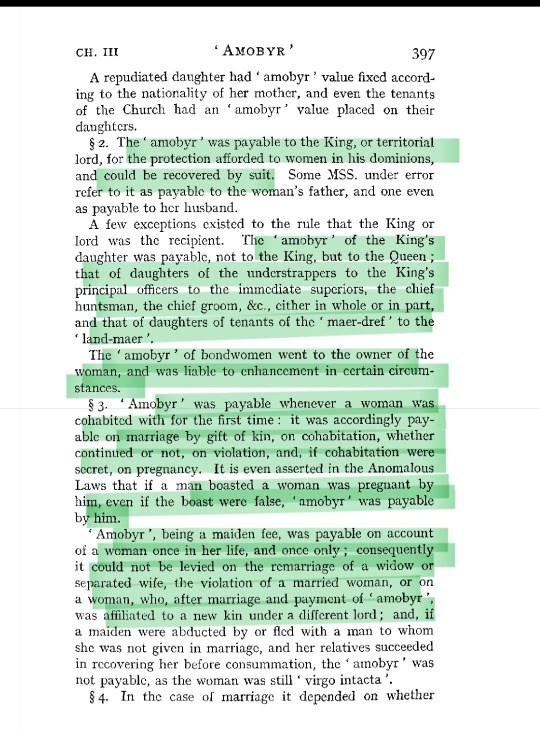

Now, amobyr could be recovered by suit as it was payable to the King and was essentially like protection money. If you made off with somebody's amobyr you were in BIG TROUBLE. HOWEVER, and I really love this fact, the King's daughter's amobyr would be payable not to him BUT TO THE QUEEN, as well as other daughters of high rank like your Pencerddau, chief groom, etc.
Amobyr was payable once a couple had cohabited for the first time, and even had to be payable if a man boasted that he'd shagged a woman and gotten her pregnant, but actually hadn't. Presumably because a) these laws are BIG on honour bonds and things and because you'd lied you'd tarnished that woman's honour and your own, and b) you'd kinda claimed that Lady as yours because you've made her unchaste.
Because it's a maiden fee it - like the Cowyll ' could only be paid ONCE. No more, no less. If you were a widow or wanted remarry, you can't get the amobyr again. Also, if you'd eloped with a dude and your family had caught you before you'd consummated your relationship they didn't have to pay cuz you're still a virgin. Also, if you were raped then the rapist had to pay amobyr to your family in recognition of that.
Finally, a lady who'd had a fling which had resulted in a bastard child* but she hadn't declared who the father was, then she was responsible for the amobyr. However, if she HAD declared who the father was then he had to pay the amobyr instead.
The Cowyll, as I've already said, is a personal payment to the lady that's made on the first morning after marriage.

Now, in North Wales it's always given as money even if you're a King's daughter, BUT if you're in the South then you get la lovely chunk of land. So if you married a prince of Gwynedd, bad luck, just money for u. If you married a Prince of Deheubarth then you are QUIDS IN! (THAT'S YOURS FOR LIFE BABYYYYY)

(Ignore the Agweddi for today. Or don't. Think of it as a tantalising glimpse into the next law I'm gonna cover.)
Cowyll is both paid to just married women AND those who were violated against their will. The wife / lady who had been violated had the right to specify what they wished for their cowyll to be in service of. If she didn't then it just went on stuff for the couple, so I'd imagine whatever the medieval equivalent of IKEA flat pack furniture would've been, that would've been what they'd have chosen.
Also, it's kept entirely separate from the husband's property so he Could Not pinch from it, or use it in service of himself. You couldn't even be deprived of it if you'd had an affair or did any naughty business. That's YOUR MONEY AND BY GOD YOU CAN KEEP IT. Even if you divorced your husband or he you, you would be allowed take your cowyll with you.
Now, finally, QUEENSHIP.
(Particularly handy if you are, like me, doing an Arthurian-inspired, Welsh-set novel and you GOTTA KNOW WHAT GUINEVERE DOES.)
There is not a lot on it because it isn't something that's studied that much (idk why. Wales has tonnes of cool Queens even if they didn't become regent) but we make do with what we can!
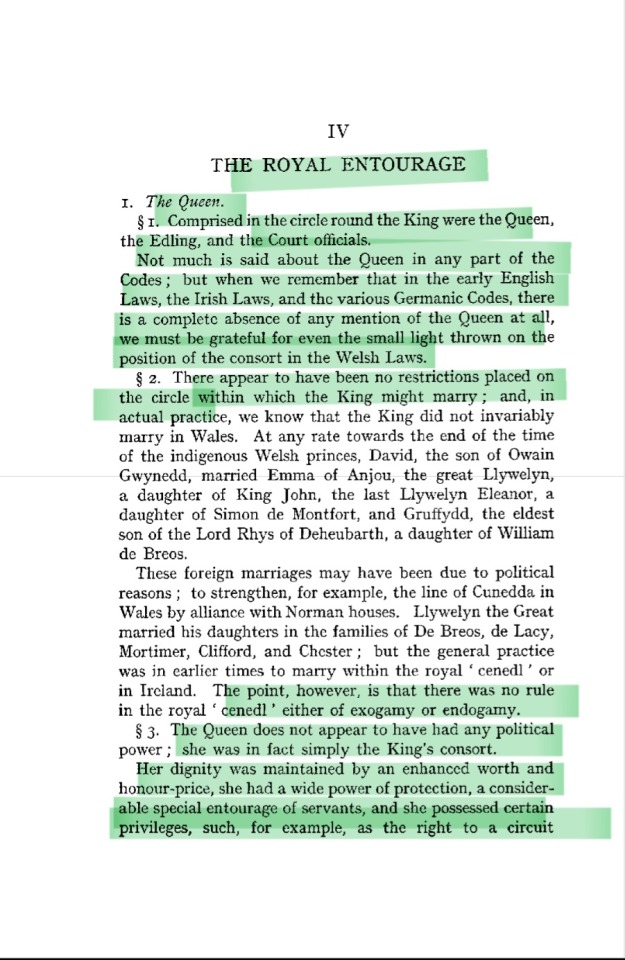


You, as King, could marry ANYBODY (Within reason, nobody is marrying a peasant girl) within what would be termed your Cenedl (that's your family.) or out of it.
Kings, we know, often married their first cousins, or second cousins to keep the balance of power within Wales (you gotta remember Wales wasn't united back then! Gwynedd, Powys, and Deheubarth fuckin squabbled like dogs over bones, and Do Not get me started on the littler kingdoms like Arwystli or Senghenydd.)
Seriously, Gwenllian ap Gruffudd ap Cynan (Gwynedd) eloped with Gruffydd ap Rhys (Deheubarth) and they were like distantly related. Or, Gwenllian's brother and v famous boi, Owain Gwynedd married his first cousin, Cristina (and, in doing so, ensured that after his death Gwynedd would have a power vacuum because of squabbling that wouldn't be sorted until Llywelyn Fawr took the throne and overthrew his uncles. It's always fuckin Gwynedd. Even Gwenllian's son, The Lord Rhys, married one of his first cousins, who was also named Gwenllian.)
*Gets slapped with a wet fish* Sorry, I was rambling.
Now, kings did also marry for political alliances. Gruffudd ap Cynan himself married Angharad ferch Owain (can u sense a theme with the names?) because she was from a well-off, noble family who had ties to the Anglo-Saxons when Gwynedd was in a bad spot with the Norman's. Llywelyn Fawr married Joan, the illegitimate daughter of King John of England, when relations became... tense, shall we say.
So, lemme go over some stuff regarding laws real quick before I tell u why I've highlighted these three ladies. (Cuz they're fun and I'm in love with them- uh, you what?)
So all the Codes (North, South, Mid) attach the following to the Queen: a steward, priest, chief groom, door-keeper, and a handmaiden. In Gwynedd she was also given a page, a separate cook (presumably because of poisoning attempts), and a candle-bearer (would LOVE to be that. No joke.) Whereas in Deheubarth she was given a groom of the rein, a sewer, and a footholder. (For all u lovers of the Fourth Branch of the Mabinogi out there this is a win for u.)
The line of Cunedda which (and, fuck me, I can't believe I'm saying this) IS BASICALLY ALL OF THE KINGDOMS OF WALES allowed for transition of royal dignity through a the female as well as the male. That means u could contest ur throne using your mam's blood and status as well as your dad's. Owain Glyndŵr, as I have previously mentioned, did this when he started his rebellion against Henry IV, as his mother descended from both the houses of Gwynedd and Deheubarth and his father descended from Powys. Truly, the people's Prince.
Now, a queen had her own privy purse (Go her), and one-third of the income the king received went to the Queen for her personal use. She also received land grants that went directly to her.
Now, finally, why tf did I highlight those three Queens that I spoke about earlier? Okay, so, Queens couldn't be regents, BUT they absolutely could and did use their power in any way they could.
Angharad ferch Owain was the mother of Owain Gwynedd, Gwenllian, and Cadwaladr. Owain Gwynedd ruled Gwynedd after his dad died in 1137 and led Gwynedd to become Wales' most successful kingdom at that time. He is also the reason why the Prince of Wales is called the Prince of Wales. ANYWAY. He and Cadwaladr had a falling out in 1143 and Angharad, not liking the way Cadwaladr was being treated, took his side. (Dunno why, he killed her step-grandson, Anarawd. Like, Angharad pls. Priorities, del.)
So, Owain ordered his son, Hywel, (yes him of bardic fame) to BURN DOWN Cadwaladr's castle in Aberystwyth. Cadwaladr, enraged, hot-footed it to Ireland where he and the Vikings invaded Gwynedd in an attempt to make Owain give him his lands back.
Angharad supported Cadwaladr by allowing him to beach his forces in her lands of Abermenai in Ynys Môn (Anglesey.) and also tried to intercede on her son's behalf with his brother. Anyways, the brothers were reconciled (for a brief period. Cadwaladr was aligned with the Normans so he remained a thorn in his big bro's side.) and Angharad lived until 1162. Her death led Owain Gwynedd into a melancholic spell.
Gwenllian ferch Gruffudd ap Cynan waged war against the Normans during the Great Revolt. Fighting against the Normans was very much a family affair for, you see, her brothers Owain (previously mentioned cousin-marrier) and Cadwaladr also waged war against the Normans at this time, and their dad, Gruffudd ap Cynan also fought against them SO HE COULD BECOME KING OF GWYNEDD. After her husband left Deheubarth to go and plead with her father for troops and aid men flocked to her and they waged a guerrilla war against the Normans until 1136.
This pains me to say but a Welsh lord betrayed Gwenllian after the Normans - seeking to win back the territory that Gwenllian and Gruffydd ap Rhys had recovered - waged war against them. She and her two eldest sons, Morgan, and Maelgwn died. Morgan in battle, and Maelgwn and Gwenllian were beheaded at Castell Cydweli.
After her death, South Wales rose in rebellion against the Normans. Her brothers, once word reached Gwynedd, invaded Norman-controlled Ceredigion (which was Deheubarth's territory.) and won back Aberystwyth, Llanfihangel, and Llanbadarn. The Welsh battle cry for many years was 'Dial Achos Gwenllian!' Revenge for Gwenllian.
Finally, Joan, Lady of Wales. She's referred to as Siwan in Welsh. She was the daughter of King John (as previously said.) She often mediated between her father and her husband, Llywelyn Fawr. The Brut y Tywysogion writes: 'Llywelyn, being unable to suffer the king's rage, sent his wife, the king's daughter, to him, by the counsel of his leading men, to seek to make peace with the king on whatever terms he could.' I'll probably do a full post about her at some point but yeah, she's cool!
Anyways, hope u enjoyed this!
Okay, hywl fawr!
#the laws of hywel dda#welsh laws#wales#cymru#arthuriana#sort of#joan lady of wales#angharad ferch owain#gwenllian ferch gruffudd ap cynan#welsh history#hanes gymraeg#arthurian mythology#welsh marriage laws#queenship#is this useful to the arthuriana crowd?#welsh monarchy#the house of aberffraw#welsh mythology#welsh stuff#it me#my writing#arthurian legend#welsh wedding laws#celtic laws#mabinogion#the mabinogion#queen guinevere#historical research#welsh queenship
48 notes
·
View notes
Note
first of all: I am having a blast with Camlann, it's been a while since I've excitedly awaited the new episodes of an audio drama! Thank you for putting this amazing story out in the world :) I have Very Important Burning Questions after the main character descriptions - 1) what type of dog/breed is Gelert? 2) is Gwaine a snapback guy? 3) are there any sort of headcanons floating around regarding Kay's appearance (ngl, I heard him speak and I was immidiately like. yeah. this checks out. annoying little shit :) ) bonus question: has there been any concious choice made for the spelling of the names? as someone who has studied the mabinogi and had to translate sections pwyll and branwen (and voluntarily had a go at Yr Afallenau Myrddin), I have noticed my brain tends to default to certain spellings, so I was wondering if there is a reason for the spellings you've chosen?
Hello hello hello!!!! Thank you so much for the kind words this is lovely of you!!!!
Regarding your questions:
Gelert is an Irish Wolfhound! Big grey boi
Hmmm, snapback might be slightly too American for him. Gwaine is quite proudly Scottish. He was living in Bristol though, so he's definitely a fashionable sunglasses guy.
Hahaha yep! Honestly with Kay the defining feature is Forgettable. Like, I'm kind of joking and I'm kind of not. He's someone who easily blends into crowds and who people tend to pass over and underestimate. He was a scrum-half on the rugby team, so he's definitely wiry. But he's not bulky, and I always imagine everything about him being a bit washed out. I also imagine him as shorter than Arthur and Gwaine.
Kind of! Also hell YES fellow medieval Welsh person!! So broadly speaking when it comes to the character's modern names I wanted very modernised, easy to pronounce names. This is partly a practical issue - the actors have to say the names a lot, and not all of them speak Welsh. But it's also about the fact that Camlann is very much a story that rejects the premise that there is a 'pure' or 'true' version of any story, or the idea that you need the oldest or most accurate name to really connect with it. So with Gwaine - Gavin, Owen, Owain etc could work just as well as Gawain. It's also sometimes a character choice - for example Dai very specifically wanted to keep using a Welsh name when he moved to England. Dai is easy for English speakers to say, but still distinctively Welsh, so it was the compromise he settled for. And then sometimes it's kind of a backstory thing - Gwen's Dad Kai taught Western Literature at a university in Hong Kong. He was a single dad, and Gwen was his only child, so they're very close. Gwen's mother gave her her Chinese name, Shújūn, but left when she was a baby. So, (unusually), Gwen and her Dad chose her English name together when she was a teenager. But because Kai taught broadly Western Literature, he was working with English Arthuriana rather than Welsh, hence Guinevere/Gwen instead of, for example, Gwenhwyfar.
Thank you so much for the questions, andf for listening to the show!!! It's always exciting to get a chance to ramble about it.
30 notes
·
View notes
Note
⭐ :)
So all the rest of the day, whilst the sun was going to meet the horizon, they went round with the baskets in hand, returning the sad or proud penises with methods as varied as the penises. Arthur gingerly held out his basket, trying not to look it or his mother in the eye, whilst the owners rooted round in his stock like the patrons of a market. Gwaine was lobbing them into the crowd like a kennel master feeding his hounds. And just as in a kennel there was a delirious fuming round the meat, and bodies going over or through one another; and afterward the crowd drawing back like the tide, with only a few sad rejects forlorn in the dust. Percival, Leon, and Elyan were carrying out the task with as much dignity as was possible; though Elyan got into a bit of a row which escalated to shoving when someone tried to claim more than his share.
And whilst Lancelot and Gwen were helping one another, to get the thing over with as quickly as possible, and Igraine was handing out her own basket with brisk efficiency, Hunith was lecturing. Each man before getting back what he was owed had to be blistered by her opinion of him. She was like the torturer which holds his victim’s feet over a fire; except she was doing it to their conscience. There were some of them brought to tears, and one left inconsolable, without even taking what he had come for.
But as it happened, she had saved all her violence for the last. They had thought she was getting the anger out of her; but really she was building it up. She was stacking it as clouds stack for a thunderstorm. She took out the final penis from her basket, and slapped the man who was there to collect it across the face. “Shame on you, you nasty old sod,” she shouted at him. They had thought she would stop with the first slap; there is a certain point made by slapping a grown man with his own penis, and it does not really need to be elaborated upon. But she continued to hit him. She was beating him over the head with it as some wives hit their husbands during a domestic; though generally they are using a broom, or a cooking pot, if they would rather be a widow than a wife.
Thus endeth the first Quest of the Knights of the Round Table.
The best thing I've ever written was the Penis Tree itself, but the second best thing I've ever written was Hunith beating a man over his head with his own penis after a sorceress stole it from him and decorated a tree with it. Truly iconic of me. Arthuriana always needed more quests with penis trees, and I really delivered here. Even my Imposter Syndrome is satisfied with this.
Fic ask game
4 notes
·
View notes
Text
The Green Knight as a Fairy Journey
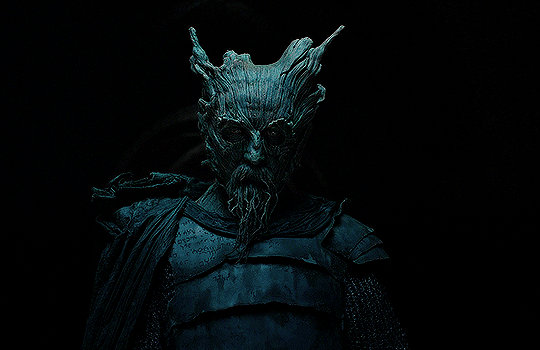
"In this domain more marvels have by men been seen
than in any other that I know of since that olden time."
- Sir Gawain and the Green Knight, translated by J. R. R. Tolkien
In my previous post, we talked about how Arthurian legend combines pagan and Christian elements to create a syncretic mythology. The Holy Grail, for example, is explicitly connected to Christian myths around the death of Jesus, but it may also be related to Irish and Welsh myths about divine cauldrons with healing properties. A lot of Arthuriana is like that -- a patchwork quilt of pagan and Christian elements.
One of the most unapologetically pagan Arthurian legends is Sir Gawain and the Green Knight. This tale has it all -- sex, violence, magic items, and a Green Man figure whose appearances are tied to the winter solstice. While Christian elements are still present (like Gawain's shield which bears an image of the Virgin Mary), they take a backseat to a pretty straightforward fairy story.
Sir Gawain and the Green Knight is a fairy story both in the sense that it features at least one of the Good People (the titular green dude) and in that it follows the protagonist on a journey into the realm of the Good People which is, confusingly, also called Fairy. In studying fairy lore for an upcoming project, I realized how similar this story is to other Fairy Journey narratives from the British Isles, and I think reading it through that lens can help explain a lot of the elements that don't always make sense to modern audiences.
The story opens with a Christmas celebration at the court of King Arthur. Ye olde partying is interrupted by the arrival of a mysterious knight, who is both bigger than a normal man and entirely green, from his skin to his hair to his clothes and even his horse. The visitor says he has heard tales of Arthur's knights and wants to test their bravery. He proposes a game: he will allow any man in the room the chance to swing at him with his (probably enchanted) axe as long as they will allow him to return the favor in a year and a day. Arthur's nephew, Gawain, accepts this challenge. Gawain beheads the Green Knight with his own axe, but instead of dying the Knight picks up his decapitated head, gets back on his horse, and reminds Gawain of his promise before leaving.
The fact that the stranger who visits Arthur's court has Otherwordly origins is explicitly stated in the text: "in his face and form that showed; / as a fay-man fell he passed, / and green all over glowed." [Emphasis added, quote from Tolkien's translation.]
In other words: "His face and body looked like a terrible fairy man and glowed green all over."
In their book Fairies, A Guide to the Celtic Fair Folk, Morgan Daimler says that green is probably the most well-known color associated with the Good People, and that they are often described as wearing green. Daimler also points out that the Good People often appear wearing a combination of green and red -- usually green with red accents. It's worth noting here that the Green Knight is described as having red eyes.
When he enters Arthur's hall, the Green Knight is described as holding an ax in one hand and a holly bough in the other. Some authors have argued that this connects him to the Holly King, a figure who represents winter in British folklore. Author John T. Kruse says in his book Faery: A Guide to the Lore, Magic, & World of the Good Folk that holly was used to protect the home from the Other Crowd, but at the same time they were said to shelter under it in the winter. This connects the Green Knight once again to Fairy, and to midwinter.
There are a few details in the encounter in Arthur's court that seem to indicate fae mischief. First, the Green Knight proposes that he accept a blow from one of Arthur's knights and be allowed to return it in a year and a day -- this time frame is common in fairy stories. Second, he asks to know Gawain's name before they begin. Names have power in Fairy, and Gawain freely giving his name to the Green Knight may be what allows the Knight to trick him later in the story.
The following year, Gawain sets out after All Soul's Day (Samhain) to search for the Green Knight. He cannot find any sign of the Green Knight or of the Knight's home, the Green Chapel in England or Wales, and we are told he wanders into "countries unknown." The poem skims over this part of Gawain's journey, but we're told he fights with worms (possibly referring to dragons), wood-trolls, and ogres. It seems pretty clear that at this point Gawain is in the Otherworld.
Gawain eventually arrives at a beautiful estate which belongs to a man named Bertilak. Bertilak's court is consistent with descriptions of Fairy courts -- wealthy and opulent, but very similar to contemporary human society.
The way the poet describes Bertilak's wife may also hint that this is a Fairy court. Lady Bertilak is described as supernaturally beautiful, and Gawain feels immediately drawn to her. This is similar to descriptions of Fairy Queens throughout the Ireland, Wales, and the British Isles.
When Bertilak learns that Gawain is looking for the Green Chapel, he tells him that it is very close by and suggests that Gawain stay with them to regain his strength before going on. Gawain agrees, and Bertilak proposes a game: Bertilak will go hunting, and each day he will give Gawain whatever he gets on his hunt. In exchange, Gawain will give Bertilak whatever he gets in Bertilak's house.
On the first morning, after Bertilak leaves to hunt, Lady Bertilak sneaks into Gawain's bed and offers him sex. ("To my body will you welcome be / of delight to take your fill; / for need constraineth me / to serve you, and I will.") This exploits a paradox in the knight's code Gawain lives by: a knight is required to do anything a noble woman asks, but sleeping with a married woman is a serious sin. Gawain compromises by kssing Lady Bertilak, but not going any further.
That night, Bertilak returns and gives Gawain deer he has killed. Gawain responds by giving Bertilak a kiss ("His fair neck he enfolded then fast in his arms, / and kissed him with all the kindness that his courtesy knew"), but refuses to tell him who he "won" it from.
The next day, Bertilak hunts a boar with his men. Lady Bertilak visits Gawain again, and this time she kisses him twice. When Bertilak returns, he gives Gawain the boar. Gawain gives him the two kisses but refuses to tell him what happened.
On the third day, while Bertilak is hunting a fox, Lady Bertilak visits Gawain and insists on giving him a gift. She offers him her girdle. (Which, for those not familiar, is an undergarment -- it's like the medieval equivalent of offering a man your bra.) Gawain refuses this very inappropriate gift, but Lady Bertilak tells him that the girdle is enchanted and will protect him from physical harm. Gawain takes it, thinking it might save him when he faces the Green Knight. When Bertilak returns and gives Gawain the fox, Gawain keeps the girdle for himself.
Let's unpack this part of the story. First, it's unusual for hunting to be this good in midwinter -- Gawain even comments on how strange it is that Bertilak found such good venison at Christmastime. This is another hint that Bertilak's lands are not bound to the same cycle of the seasons as ours. Daimler notes that Fairy often appears green and bountiful, even when it is winter in the human world.
Second, Lady Bertilak's seduction of Gawain falls into a larger pattern of Fairy Queens taking mortal lovers. The Queen often offers her lovers some kind of magical gift or supernatural power in exchange for their affection, but this often comes at a price. In Gawain's case, his fairy lover grants him protection from harm at the cost of compromising his vows as a knight and lying to her husband.
Third, this fits into the "seduction test" story type. For example: in the first branch of the Welsh Mabinogion, the hero Pwyll trades places with Arawn, lord of the Otherworld, for an entire year but refuses to sleep with Arawn's wife. After this, the two are lifelong friends, and Arawn continues to be friendly to Pwyll's descendents after Pwyll dies.
Gawain finally leaves Bertilak and his wife, wearing Lady Bertilak's girdle for protection. He reaches the Green Chapel, where the Green Knight is waiting for him. The Green Knight fakes him out twice, then gives him a very small cut on the neck. He then reveals that he is Bertilak, and that the cut was a punishment for hiding the girdle Gawain took from his wife. He adds that he doesn't blame Gawain, because he knows he only took the girdle to save his own life. Aside from a little blood and a lot of embarrassment, Gawain is fine.
Bertilak's appearance was changed by Morgan le Fay, who he also calls Morgan the Goddess. (Morgan le Fay LITERALLY means Morgan the Fairy.) He invites Gawain to return to his house to meet Morgan and to celebrate, but Gawain refuses and returns to Camelot instead.
Sir Gawain and the Green Knight makes much more sense as a straightforward tale of a journey into Fairy than it does as a Christian morality tale. The Green Knight is clearly an Otherworldly figure, and both Lady Bertilak and Morgan le Fay fit the role of the Fairy Queen. The test of virtue is consistent with older stories of Otherworld journeys, and Bertilak's home being in Fairy explains how there is such good hunting in the middle of winter.
#have this essay i wrote before i caught covid#arthuriana as a british mythological system is a new hyperfixation#in case you couldn't tell#sir gawain and the green knight#the green knight#sir gawain#gawain#arthuriana#arthurian legend#arthurian lore#arthurian literature#medieval literature#medieval history#fairy#fairy lore#fairy story#folklore#british folklore#classic lit#classic lit aesthetic#classic literature#academia#light academia#dark acamedia#paganism#pagan#witch#witchblr#fairy witch#morgan le fay
203 notes
·
View notes
Text
personal reflection/venting post
I almost never do this but I need to do some, like, tumblr journaling:
Today is May 1st, which is an important day in Arthurian legend, which is one of my longest-running interests and actually the reason I joined tumblr in the first place (I want to follow an Arthuriana blog). It's got me thinking back to what kind of person I was at 17, when I discovered the music of Heather Dale and became interested in the legend. I was very depressed and anxious back then, but I still had so much capacity for genuine passion, and my sudden obsession with all things Arthur was possibly the best example of that. I just wanted to consume everything related to my new obsession. I can't even really describe it, but the key thing is that there was no self-consciousness to get in the way. I never once worried that I was being cringe or problematic or whatever the judgmental adjective du jour is. And I'm contrasting that 17-year-old with who I am now, and the contrast makes me want to cry. I feel like I've just utterly lost the capacity for that kind of unrestrained, unapologetic excitement, and there are probably multiple factors at play, but I'm certain that one of them, probably the biggest, is social media. I spend so much time seeing the most joyless, mean-spirited people imaginable tear down everything and everyone—sometimes under the guise of making Important Criticisms, sometimes just as an act of unrepentant unpleasantness—that an amalgamation of their voices has taken up residence in my brain, and it tries to tear down everything it sees. I can hardly read a book or watch a youtube video or listen to a song or have an idea without this obnoxious, irony-poisoned part of my brain try to guess what the most annoying people imaginable would say about it—how they'd tear it apart, how they'd paint it/me as problematic or cringe or offensive or boring or just bad. I hate this! I hate that the "paranoid reading" (really useful concept, btw) approach to the world has taken root in my mind! I hate that it's so hard for me to just enjoy things and be interested in things and, more basically, just enjoy things without worrying what people I don't even like or respect would think! I hate that my impulse was to include the word "pathetic" in the title of this post, because I know from observation that irony and self-deprecation are more valued by a lot of obnoxious losers on social media than earnestness. I hate that there are so many obstacles in my brain to just earnestly being interested in something, eventually I tend to just give up instead of trying to get past them. I really, really need to get un-poisoned. I'm never giving up on tumblr, but I do need to use it less. I'm going to log out and, after work (I'm on my lunch break), I'm going to listen to "The Lusty Month of May" from Camelot and "Mordred's Lullaby" and "The Trial of Lancelot" by Heather Dale and reread my college thesis, which was about Arthurian stuff. Surely it's possible to get back at least a bit of who I used to be.
EDIT: I was going to try to stay logged out for the rest of the day, but I had to log back in to reblog a post I always reblog on May 1st, so while I'm here, I want to clarify one thing that I didn't get a chance to clarify earlier because my lunch break was over: it's not just "the most joyless, mean-spirited people imaginable" who are the cause of this problem. I mean, they're by far the biggest part of the problem, but I think it's also bad for me to be constantly bombarded by the opinions of even sensible, decent people who are objectively not doing anything wrong. I think the fundamental problem is that, for me at least, being constantly exposed to other people's opinions, even when those opinions are perfectly valid and expressed civilly, makes it hard for me to do or think anything without feeling like there's an invisible crowd offering their input because I'm so used to a real crowd offering their input on every single thing. Maybe some people are psychologically strong enough that it doesn't affect them, but I'm clearly not one of those people. So I'm going to reblog the post I came on here to reblog, then I'm going to log out again, and this time I'm genuinely going to stay logged out for the rest of the day.
7 notes
·
View notes
Text
Long time no talk! We got COVID and we’re coping with memes.
Remember this?

Welcome to:

Image ID: First image is the chucking a ball meme, where the girl chucking the ball is labelled Apollo, and the ball is labelled, "the gift of prophecy," and the girls shrieking are labelled, "Jackie and Molly naming Omikron. Second image is that same chucking the ball meme, where the ball is labeled “Omicron,” the girl chucking it is labeled with a French flag, and the girls she’s chucking it at are labeled, “Jackie and Molly.”
How did we get COVID, you ask? Only in the most in-character way possible. Consider: Jackie got COVID at the Pride Parade when an old man came over to us to shout about how much he supports lesbians. 24 hours later, Jackie unknowingly gave Molly COVID while discussing best practices in Arthuriana.
Here is a convenient visual representation:


Image ID: In the first image, Jackie is standing in a not super crowded gay pride street, posing festively. She is labeled in pink handwirintg, “Just got COVID.” In the second image, Jackie and Molly are drinking rose outside. Above them in the same pink handwriting reads, “Giving her COVID” with little pink drawn lines passing from Jackie to Molly.
12 notes
·
View notes
Text
British LegendsxPokémon
Gawain
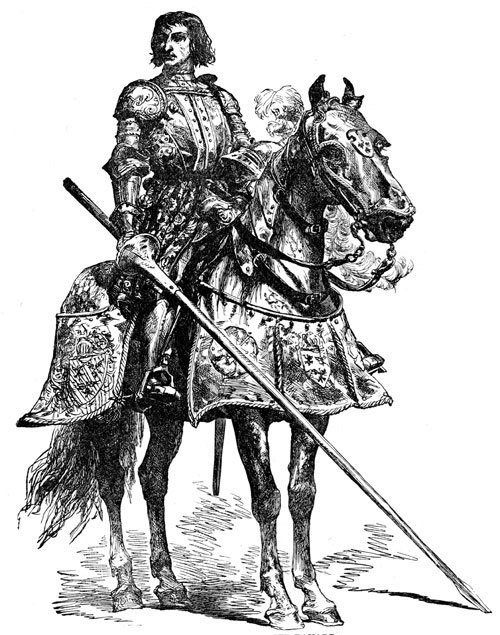

As one a pearl doth prize, measured ’gainst pease, tho’ white, So do I hold Gawain above all other knight!
Didst thou a little lack, Sir Knight, in loyalty,
’T was not for woman’s love, or aught of villainy,
’T was but for love of life, therefore I blame thee less—”
Sir Gawain and the Green Knight
For the longest time I had Solrock on his team. But I was never 100% comfortable with it because as the Maiden’s Knight I wanted to give Gawain only female Pokémon and Solrock is genderless (I also thought about giving him Braviary but Braviary can only be male). But luckily for me I looked up the Pokémon Species Type (for different reasons) and we have 4 sun/ne Pokémon (which doesn’t include Solrock).
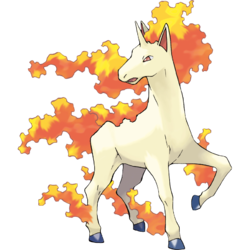
Gringolet, Gawain’s horse has his own Wikipedia article. Not even Owain’s lion has that! Also Gawain’s Scottish, so unicorn. I was debating between Rapidash and Musdale because Gawain does have a story including a donkey. But Musdale is a working horse and Gawain is a knight. Rapidash feels more knightly.
Ponyta was Gawain’s first Pokémon. Gawain had found her in the field grassing. Slowly, the young (let’s say 5) Gawain would go closer to Ponyta every day. He would leave berries for her hoping she would come to him. Ponyta got spooked the few first times but sensing Gawain was kind, she let him come closer. Eventually, she came to Gawain. Once, Gawain tried to pet her, which surprised Ponyta and Gawain got burned. Gawain learned his lesson and the next time, he asked Ponyta’s permission to pet her. She gave him permission.
Neither one of them noticed when Ponyta left the fields and started to sleep in the stables with Gawain, but it didn’t matter. They were each other’s. (I’m going to make Gawain working at the stables for the Pope, ‘cause why not.)
Ponyta and young Gawain worked together and went on adventure together, both loving to explore. With Ponyta, Gawain was able to go places faster and help people. Classic knight errant stuff, but as a preteen.
Ponyta evolved into Rapidash during a joust. Gawain wanted to impress his uncle. Gawain was actually doing very well. He makes it to the end! And he was against a knight on a Rhyhorn. They would have lost if Ponyta didn’t evolve into Rapidash and won them the joust (Yes I am imagining that scene in the anime where Ash riding a Ponyta evolves into a Rapidash.)
The only time Rapidash goes into her pokéball is when Gawain is outside in the rain. But usually she hates her pokéball. Sometimes Gawain more time on her then he does walking.
Her moveset is Stomp, Fire Blitz, Megahorn and Poison Jab.

The Ralts line is partly based on knights. Why Gardevoir and not Gallade? Gallade cannot be female. (Also Gallade works with Guinevere.)
During his explorations, young Gawain and Ponyta found a Ralts in need of help. She was being attacked by a Ferroseed. She was locked into place unable to teleport. Ponyta used ember and the Ferroseed ran away. Gawain brings Ralts “home” aka still the stables in Rome. (Now I’m imagining them using Ralts during mass, it’s adorable in my mind.) Ralts becomes Gawain’s main battler. They sadly lost their first Little Cup tournament. But both of them worked hard and they won their next tournament using confusion!
She evolved into a Kirlia during a tournament, which because she evolved, Gawain was unable to use her. He lost the tournament.
Kirlia wasn’t just used for tournaments but in his adventures Gawain would often use her in battle and to help fight the wild Pokémon.
And in a reference to the Rise of Sir Gawain, Nephew of Arthur, she evolved into Gardevoir during the pirate battle. (I will never not think that’s cool.)
Gardevoir helped Gawain in negotiations when Arthur sent him away to talk with Arthur’s lords or neighbouring kings. Once when the negotiations were going bad, she created a black hole and scared a King in swearing his alliance to Arthur. (She’s still a fairy and they are mischievous.)
Gardevoir’s moveset is Moonblast, Psychic, Thunderbolt and Calm Mind.
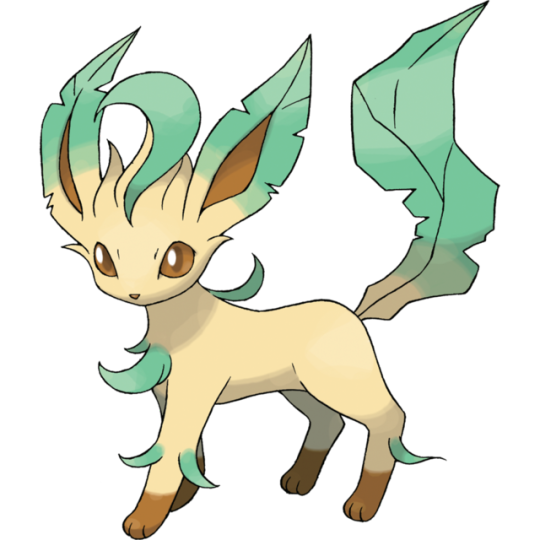
When his character is not being butchered, Gawain is often a peace keeper. Leafeon is a piece keeper. Seriously, Platinum Pokédex: It basically does not fight. With cells similar to those of plants, it can perform photosynthesis. Also it gets stronger in the sun, like Gawain. And might be a reference to Sir Gawain and the Green Knight, being green.
In the forest of Italy (because honestly it’s Arthuriana and the forest is magical and Pokémon has tons of Pokémon in the forest), while training Ralts, they found an Eevee sunbathing. Gawain decided to catch her. Eevee was more peaceful and she didn’t battle unless she had to. Though once a Surskit was bullying Ponyta, Ponyta kept trying to stomp on it but it wasn’t working. Eevee tackled the Surskit helping her friend.
In the Magical Forest of Adventure, Eevee had the nighttime munchies and found a mossy rock. Everyone was very surprised the next morning when Leafeon was sleeping with them. They blamed fairies.
Leafeon didn’t change much in personality. She is still very protective of her family and Gawain. Maybe some times a little to protective, getting revenge on people that wronged them.
Her moves are Leaf Blade, Sword Dance, X-Scissor and Synthesis.

Yes, based on both Mexican wrestlers and Aztec Eagle Warriors (seriously) doesn’t match a medieval knight, he is a hawk. And Gwalchmai may (there’s debate) mean Hawk of May.
After getting knighted Sir Gawain from the Pope, Gawain went back home to find his family. He met with Morgause and Lot and Agravaine and Gaheris and Soredamour. There was a family tradition when the child turn 13, they give them an egg of a flying type. Lot gave Gawain a Pokémon an egg, which hatched into a Hawlucha (I know Hawlucha is in the human-like egg group but magic was involved). Gardevoir and Leafeon were mainly her mothers. I’m also imagining Gawain and Hawlucha practicing fighting moves together. Gawain once wrestled Agravain and Gaheris at the same time using moves he learned from Hawlucha.
Hawlucha loved to tournaments. She made a septicle of the whole thing, which made her popular with the crowd as well. Though, sometimes she got into her own head and while showboating she got hit.
Her moveset is Sky Attack, Hi Jump Kick, Flying Press and Stone Edge.

Did you know Espeon is the Sun Pokémon? It also matches Mordred's Umbreon (spoilers).
Gawain was making a name for himself not just in the tournament scene but also in the adventure scene (sure he had a little hiccup with Owain/Morholt/Gawain maiden adventure but generally it was very positive). While on an adventure, Gawain slept with a woman who’s Vaporeon really liked Leafeon. Leafeon gave birth to two Eevees. Gawain kept one but gave the other to his little brother Mordred who was starting his Pokémon adventure. Eevee was easier to raise then Hawlucha for Leafeon. Eevee was always quick learning and loved to sleep with Gawain at night (which she kept doing after evolving). Some nights Gawain found her on his face sleeping (this did not continue after evolution).
Eevee evolved pretty quickly, like I said quick learning. On a bright day, resting from travel, Gawain was playing with Eevee. He threw a stick and the stick stopped in mid air. Having so much fun, Eevee evolved into an Espeon. (Basically the Eevees evolve in nontraditional ways.)
Espeon liked tournaments and showing off her precognition powers (blame it on Hawlucha’s influence).
Her moveset is Psychic, Shadow Ball, Toxic and Future Sight
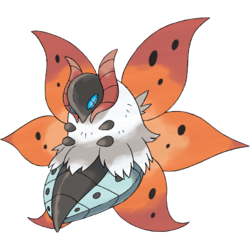
Did you know that Volcarona is the Sun Pokémon? It’s partly based on sun spots.
Gawain heard about this magical Pokémon in ancient ruins. So, naturally it was adventure time (the theme of this post). He went to the ruins. It’s full of ghost and maybe a legendary? No, it was just a Volcarona. Not what was expected but still welcomed. There was a fight, where Gardevoir hits the final blow. It was as epic as any legendary battle.
After catching Volcarona, the ruins no longer caught fire randomly. So, the neighbouring town was very happy.
Volcarona like the Pokémon Dex entries say, she likes helping people and Pokémon. But, when angered, she is very dangerous.
Her moves are Fiery Dance, Bug Buzz, Quiver Dance and Heat Wave
Previous: Morgana
Next: Merlin
#yup#there are jousts and tourneys#but with a pokemon twist#pokemonxbritish legends#sir gawain#arthuriana
13 notes
·
View notes